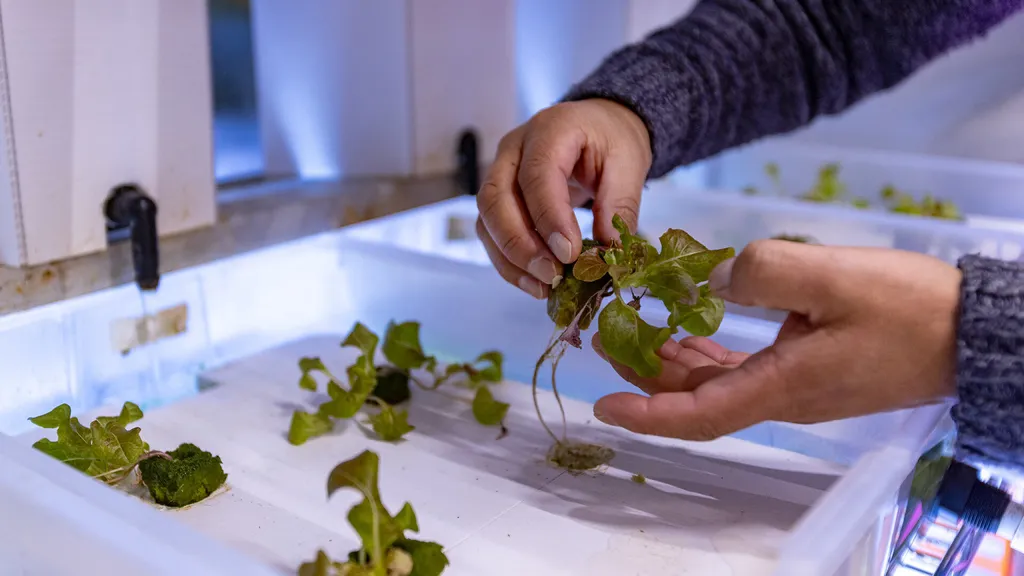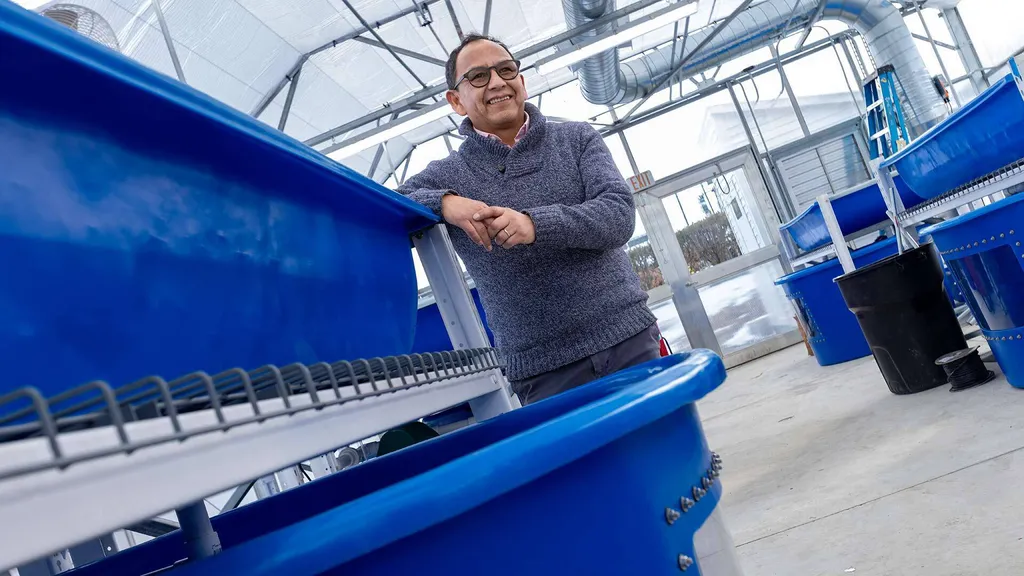- February 08, 2024
- By Maggie Haslam
In a modest, ground-floor lab deep within University of Maryland’s Animal Science Building, a redhead who goes by “Gru” is tending to a new crop of lettuce. Gru is cool, impossible to miss because of his hulking size, and drips indifference; he’ll meet your greeting with a blank stare as he chills in a quiet corner with his buddies.
Gru isn’t first string on the wrestling team or a jacked fraternity brother. He’s a goldfish. And he’s an integral part of the University of Maryland’s aquaponics lab, its first and only research and education venture dedicated to the sustainable farming method. Here, he and around 100 of his finned friends have just one job: to feed the herbs, lettuces and other veggies growing above them with their waste.
“It’s an increasingly popular method for growing food that can be done just about anywhere, and the students love it,” said Jose-Luis Izursa, a senior lecturer and academic adviser in the Department of Environmental Science and Technology. “There’s some hesitation from people because it involves fish waste. But what do they think fertilizer is?”

A farming practice that dates back to the Aztecs, aquaponics combines aquaculture (the cultivation of fish) with hydroponics (the practice of growing plants in nutrient-rich water without soil). The aquaponics cycle is both simple and symbiotic: Nutrient-rich wastewater is pumped from the fish tank into a series of filters, where “good” bacteria break down ammonia into nitrates, which the plants “eat,” flushing clean, oxygenated water back into the fish tank.
Izursa launched aquaponics at UMD in 2017 with two 50-gallon barrels, a few dozen fish and some seedlings after he found that his work on gasification—trying to harvest energy from chicken waste—wasn’t engaging students. Eventually, he was given a small lab, which is now packed with over two dozen tanks and pallets of lettuce, cucumbers, peppers, herbs and more.
Later this month, Izursa and his students will unveil an additional, 1,200-square-foot aquaponics greenhouse behind the Xfinity Center, where 210-gallon barrels filled with tilapia and yellow perch will nourish large grow beds chocked full of produce.
“It’s just so cool that it’s this self-sustaining system,” says animal sciences major Masha Berezina ’26, who with lab co-manager and animal sciences major Hadiya Grier ’25 helps oversee student work, lab maintenance, experiments and husbandry. “All we need to do at the end of the day is make sure the fish are fed.”
The existing lab, which is almost entirely run by students, is a full-time operation. Fish must be fed daily, pH levels and dissolved oxygen checked and experiments monitored. The lab has several research projects under way, including one funded by NASA, which is testing different nitrogen scavengers, and another examining the addition of microscopic, “nano” oxygen bubbles for fish and vegetable health. Other experiments have looked at growing methods and food safety.

“As a pre-vet, I didn’t know anything about aquaponics when I started, and I feel like I learn something new every time I’m there,” said Grier.
The lab, said environmental science and technology Professor William Bowerman, who was chair of the department when Izursa was getting the lab off the ground, is more than a valuable and unique education; it’s hands-on work that students crave.
“They want to get dirty, get out in the field,” he said. “The whole thing is so holistic and fits right into the innovative ‘green engineering’ that’s our future.”
For those looking to jump in the deep end of aquaponics, there’s an initial learning curve and monetary investment. Beside materials, you need to have a general knowledge of fish and plants, and know a little about plumbing and electricity. But aquafarming reaps a bounty of rewards, said Izursa: Beyond copious amounts of vegetables and herbs (the lab donates what they grow in abundance to places like the Campus Pantry, including last year’s “absurd” amount of Swiss chard), it is a very safe way to grow food; recent testing showed that filters were able to irradiate harmful bacteria like E. coli and listeria. Food can be grown year-round and virtually anywhere, and aquaponics requires only 10% of the water used in traditional agriculture.
“It’s never going to replace traditional agriculture; it would be crazy to think we’d grow wheat or corn this way,” said Izursa. “But the beauty is that you can put a greenhouse like this anywhere. It can live in warehouses or on the roof of a city building.”
In addition to studying how nutrient output from fish types can grow different varieties of leafy greens, Izursa is in talks with other faculty, the U.S. Department of Agriculture and the Food and Drug Association about conducting water quality and food safety studies in the new greenhouse. The team will also migrate from ornamental fish to edible ones—both plants and fish, including shrimp, will be harvested by the lab team for consumption.
Izursa hopes its research translates to economical, sustainable systems for farmers, restauranteurs and other people interested in this unique version of farm to table—and demonstrates that having a successful aquaponics business is like shooting fish in a barrel.
“People can be intimidated by the moving parts,” he said. “But, we want to show them that it’s really not hard.”
